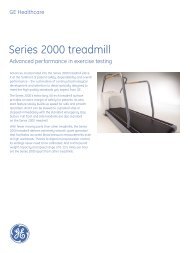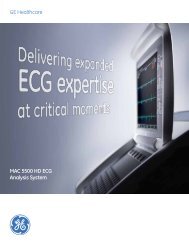Operating Instructions - Jaken Medical...
Operating Instructions - Jaken Medical...
Operating Instructions - Jaken Medical...
You also want an ePaper? Increase the reach of your titles
YUMPU automatically turns print PDFs into web optimized ePapers that Google loves.
Chapter 1<br />
General Information<br />
Safety Features<br />
WARNING: Electrical shock hazard. Do NOT contact unit or<br />
patient during deÞbrillation. Otherwise, serious injury or<br />
death could result.<br />
WARNING: NEVER position deÞbrillator paddles very close<br />
to or over ECG sensors. Remove all chest sensors (V-Leads/<br />
C-Leads) from a patient before deÞbrillation to allow proper<br />
paddle placement. Severe burns may result from improper<br />
placement of deÞbrillator paddles. Before using any<br />
deÞbrillator, consult the operating instructions for that<br />
equipment.<br />
Includes a 3-conductor, hospital-grade power cable. Includes an electrically<br />
isolated, DB-15 style patient cable. This conforms to IEC safety, pinout and<br />
mechanical requirements.<br />
This symbol which appears on the rear panel, indicates this equipment meets<br />
the requirements of Council Directive 93/42/EEC, MDD, Class IIa.<br />
This symbol next to the patient cable connector indicates this equipment is<br />
classiÞed as deÞbrillation-protected, Type CF equipment. The patient cable<br />
and input circuits are designed to prevent damage to the recorder if the unit is<br />
connected to a patient during deÞbrillation.<br />
Using Multiple Electrical Apparatus<br />
Use caution when monitoring patients who must be protected from very small<br />
electrical currents. Susceptible patients include patients with cardiac catheters<br />
or pacemakers. Consult a qualiÞed technician before using multiple electrical<br />
apparatus in this patient environment.<br />
The Eclipse patient leads are electrically isolated from ground and the device<br />
meets the most stringent IEC and ANSI/AAMI medical standards for leakage<br />
currents.<br />
However, a potential hazard may occur if the enclosure leakage currents from<br />
multiple pieces of equipment combine and are inadvertently routed directly to<br />
a patientÕs heart via a catheter or pacemaker lead. Only equipment which is<br />
certiÞed to IEC and ANSI/AAMI medical standards should be used in this<br />
environment. Use of certiÞed equipment does not, however, completely<br />
eliminate this possible hazard.<br />
Another potential hazard may occur if two devices near a patient are powered<br />
from different circuits. If the grounds of the two circuits are at different<br />
potentials, which can occur under certain fault conditions, then a ground loop<br />
can exist between the enclosures of the two devices. If devices must be<br />
powered from separate circuits in the vicinity of a susceptible patient, then the<br />
grounding lugs on the devices should be electrically connected via an<br />
equipotential cable. Please also consult Chapter 2, ÒEquipment Setup.Ó<br />
1-4 Eclipse <strong>Operating</strong> <strong>Instructions</strong>
















